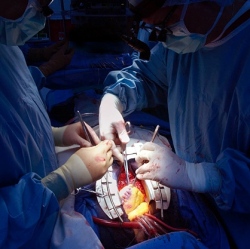
The gap between waiting list and available organs cannot be solved without living donors, because there is such a shortage in organ supply supply from deceased donors.” The good news is we’re getting closer to a future where neither living nor deceased donors will be necessary.
Let’s take a look at a few recent breakthroughs in bioprinting getting us closer to a world in which organ shortages will be a thing of the past.
3D Printed “Living” Blood Vessels
At Lawrence Livermore National Laboratory, Monica Moya and her team have developed a method which allows vascular networks to self-assemble in bioprinted tissues.
The team has successfully bioprinted structures out of cells and other biomaterials with artificial tubes to allow nutrients to flow through the the bioprinted environment. As blood flows through the artificial vessels, the vascular network self assembles, connecting to the bioprinted tubes and delivering nutrients to the cells on their own.
Bioprinted Mouse Thyroid Gland Successfully Transplanted, Human Thyroid Is Next
According to the World Health Organization, 665 million people in the world are affected by thyroid disorders. In the case of thyroid dysfunction caused by cancer, not even a donor transplant helps because patients who receive organ transplants have to undergo immunosuppression therapy, which can speed up the development of cancer cells. Moscow-based 3D Bioprinting Solutions Lab is focused on solving this problem.
In March of 2015, 3D Bioprinting Solutions became the first group to successfully bioprint a thyroid gland for a mouse with the intention of transplanting into mice. Months later, the group announced they had successfully transplanted the bioprinted thyroid and reported that after 11 weeks of monitoring the subjects’ 3D printed thyroid glands, they were in working order with completely restored function.
Last week, Vladimir Mironov, head of 3D Bioprinting Solutions, announced his laboratory is ready to start printing a human thyroid gland. They also have plans to bioprint a human kidney.
3D Printed Human Skin for Testing
San Diego headquartered Organovo designs and creates functional human tissues for use in drug testing and medical research. Earlier this year, the company partnered with L’Oreal to provide bioprinted human skin for use in testing the safety of cosmetic products.
This is just one new step for Organovo in their mission of bioprinting functioning human organs.
